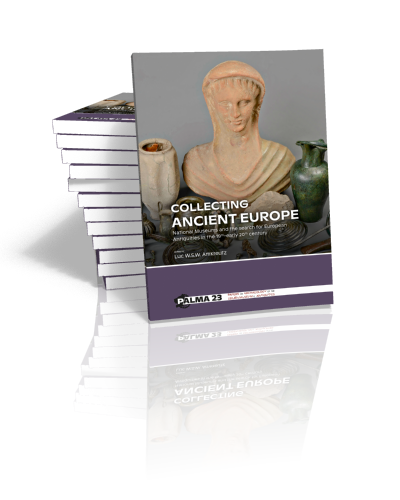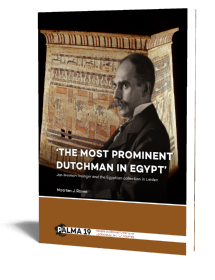Collecting Ancient Europe
National Museums and the search for European Antiquities in the 19th-early 20th century
Edited by Luc W.S.W. Amkreutz | 2020

Collecting Ancient Europe
National Museums and the search for European Antiquities in the 19th-early 20th century
Edited by Luc W.S.W. Amkreutz | 2020
Paperback ISBN: 9789088909351 | Hardback ISBN: 9789088909368 | Imprint: Sidestone Press | Format: 210x280mm | 166 pp. | Papers on Archaeology of the Leiden Museum of Antiquities 23 | Series: PALMA | Language: English | 39 illus. (bw) | 41 illus. (fc) | Keywords: Europe; heritage studies; museums; collecting; archaeology; nationalism; museology; antiquities | download cover
Read online or downloaded 986 times
-
Digital & Online access
This is a full Open Access publication, click below to buy in print, browse, or download for free.
-
Buy via Sidestone (EU & UK)
-
Buy via our Distributors (WORLD)
For non-EU or UK destinations you can buy our books via our international distributors. Although prices may vary this will ensure speedy delivery and reduction in shipping costs or import tax. But you can also order with us directly via the module above.
UK international distributor
USA international distributor
-
Bookinfo
Paperback ISBN: 9789088909351 | Hardback ISBN: 9789088909368 | Imprint: Sidestone Press | Format: 210x280mm | 166 pp. | Papers on Archaeology of the Leiden Museum of Antiquities 23 | Series: PALMA | Language: English | 39 illus. (bw) | 41 illus. (fc) | Keywords: Europe; heritage studies; museums; collecting; archaeology; nationalism; museology; antiquities | download cover
Read online or downloaded 986 times

We will plant a tree for each order containing a paperback or hardback book via OneTreePlanted.org.
In order to understand our past, we need to understand ourselves as archaeologists and our discipline. This volume presents recent research into collecting practices of European Antiquities by national museums, institutes and individuals during the 19th and early 20th-century, and the ‘Ancient Europe’ collections that resulted and remain in many museums.
This was the period during which the archaeological discipline developed as a scientific field, and the study of the archaeological paradigmatic and practical discourse of the past two centuries is therefore of importance, as are the sequence of key discoveries that shaped our field.
Many national museums arose in the early 19th century and strived to acquire archaeological objects from a wide range of countries, dating from Prehistory to the Medieval period. This was done by buying, sometimes complete collections, exchanging or copying. The networks along which these objects travelled were made up out of the ranks of diplomats, aristocracy, politicians, clergymen, military officials and scholars. There were also intensive contacts between museums and universities and there were very active private dealers.
The reasons for collecting antiquities were manifold. Many, however, started out from the idea of composing impressive collections brought together for patriotic or nationalistic purposes and for general comparative use. Later on, motives changed, and in the Dutch National Museum of Antiquities became more scientifically oriented. Eventually these collections fossilized, ending up in the depots. The times had changed and the acquisition of archaeological objects from other European countries largely came to an end.
This group of papers researches these collections of ‘Ancient Europe’ from a variety of angles. As such it forms an ideal base for further researching archaeological museum collection history and the development of the archaeological discipline.
Introduction
Luc Amkreutz
PART I MUSEUMS & INSTITUTES
The archaeology of Ancient Europe in the Berlin Museum of Pre- and Early History. Acquisition policy and collection concepts from 1829 to this day
Marion Bertram
Frédéric Troyon (1815–1866) and Arnold Morel-Fatio (1813–1887): collecting European antiquities for the Musée cantonal in Lausanne (Switzerland)
Lionel Pernet
Collecting Europe. Creation, growth and networks of the Ancient Europe collection at the Leiden National Museum of Antiquities (1824–1970)
Luc Amkreutz
From Past to Future: Can an archaeological collection of comparison be relevant in the 21st century?
Christine Lorre
Collecting European antiquities as part of the Scottish antiquarian tradition
Alison Sheridan
PART 2 SCHOLARS & COLLECTORS
Hans Hahne and the national vision of Prehistory in central Germany (1912–1935)
Regine Maraszek
“Madness and Civilization”: Dr. John Thurnam’s collection of antiquities and the British Museum’s collecting networks during the Victorian era (1839–1901)
Neil Wilkin
Different characters, different approaches. Collecting antiquities by J.H. Holwerda and A.E. van Giffen
Leo Verhart
PART 3 SITES & DISCOVERIES
The exchange value of Early Bronze Age Spanish artefacts (the ‘Siret collection’) in the Royal Museums of Art and History in Brussels
Eugène Warmenbol & Walter Leclercq
Collecting La Tène. Practices and motivations in exchanging collections from an archaeological type site
Gianna Reginelli Servais
(Re-)collecting the Frankish Cemetery of Niederbreisig in the German Rhineland
Annemarieke Willemsen
PART 4 OBJECTS & OUTREACH
In the curator’s chair. Online participation in research on the Ancient Europe collection at the National Museum of Antiquities in Leiden, the Netherlands
Rosanne van Bodegom

Prof. Dr. Luc W.S.W. Amkreutz
Since 2008 Luc Amkreutz has been the curator of Prehistory at the Dutch National Museum of Antiquities (RMO). Apart from numerous exhibitions, he worked on the 2011 new permanent exhibition ‘Archaeology of the Netherlands’, offering a fresh perspective on 300,000 years of the country’s history. He also co-created the exhibition ‘Cutting Edge Past’ in 2016 which ultimately led to the acquisition of the Ommerschans dirk in 2017. Amkreutz was appointed professor of Public Archaeology at the Faculty of Archaeology, Leiden University in 2022.
Abstract:
In order to understand our past, we need to understand ourselves as archaeologists and our discipline. This volume presents recent research into collecting practices of European Antiquities by national museums, institutes and individuals during the 19th and early 20th-century, and the ‘Ancient Europe’ collections that resulted and remain in many museums.
This was the period during which the archaeological discipline developed as a scientific field, and the study of the archaeological paradigmatic and practical discourse of the past two centuries is therefore of importance, as are the sequence of key discoveries that shaped our field.
Many national museums arose in the early 19th century and strived to acquire archaeological objects from a wide range of countries, dating from Prehistory to the Medieval period. This was done by buying, sometimes complete collections, exchanging or copying. The networks along which these objects travelled were made up out of the ranks of diplomats, aristocracy, politicians, clergymen, military officials and scholars. There were also intensive contacts between museums and universities and there were very active private dealers.
The reasons for collecting antiquities were manifold. Many, however, started out from the idea of composing impressive collections brought together for patriotic or nationalistic purposes and for general comparative use. Later on, motives changed, and in the Dutch National Museum of Antiquities became more scientifically oriented. Eventually these collections fossilized, ending up in the depots. The times had changed and the acquisition of archaeological objects from other European countries largely came to an end.
This group of papers researches these collections of ‘Ancient Europe’ from a variety of angles. As such it forms an ideal base for further researching archaeological museum collection history and the development of the archaeological discipline.
Contents
Introduction
Luc Amkreutz
PART I MUSEUMS & INSTITUTES
The archaeology of Ancient Europe in the Berlin Museum of Pre- and Early History. Acquisition policy and collection concepts from 1829 to this day
Marion Bertram
Frédéric Troyon (1815–1866) and Arnold Morel-Fatio (1813–1887): collecting European antiquities for the Musée cantonal in Lausanne (Switzerland)
Lionel Pernet
Collecting Europe. Creation, growth and networks of the Ancient Europe collection at the Leiden National Museum of Antiquities (1824–1970)
Luc Amkreutz
From Past to Future: Can an archaeological collection of comparison be relevant in the 21st century?
Christine Lorre
Collecting European antiquities as part of the Scottish antiquarian tradition
Alison Sheridan
PART 2 SCHOLARS & COLLECTORS
Hans Hahne and the national vision of Prehistory in central Germany (1912–1935)
Regine Maraszek
“Madness and Civilization”: Dr. John Thurnam’s collection of antiquities and the British Museum’s collecting networks during the Victorian era (1839–1901)
Neil Wilkin
Different characters, different approaches. Collecting antiquities by J.H. Holwerda and A.E. van Giffen
Leo Verhart
PART 3 SITES & DISCOVERIES
The exchange value of Early Bronze Age Spanish artefacts (the ‘Siret collection’) in the Royal Museums of Art and History in Brussels
Eugène Warmenbol & Walter Leclercq
Collecting La Tène. Practices and motivations in exchanging collections from an archaeological type site
Gianna Reginelli Servais
(Re-)collecting the Frankish Cemetery of Niederbreisig in the German Rhineland
Annemarieke Willemsen
PART 4 OBJECTS & OUTREACH
In the curator’s chair. Online participation in research on the Ancient Europe collection at the National Museum of Antiquities in Leiden, the Netherlands
Rosanne van Bodegom

Prof. Dr. Luc W.S.W. Amkreutz
Since 2008 Luc Amkreutz has been the curator of Prehistory at the Dutch National Museum of Antiquities (RMO). Apart from numerous exhibitions, he worked on the 2011 new permanent exhibition ‘Archaeology of the Netherlands’, offering a fresh perspective on 300,000 years of the country’s history. He also co-created the exhibition ‘Cutting Edge Past’ in 2016 which ultimately led to the acquisition of the Ommerschans dirk in 2017. Amkreutz was appointed professor of Public Archaeology at the Faculty of Archaeology, Leiden University in 2022.
-
Digital & Online access
This is a full Open Access publication, click below to buy in print, browse, or download for free.
-
Buy via Sidestone (EU & UK)
-
Buy via our Distributors (WORLD)
For non-EU or UK destinations you can buy our books via our international distributors. Although prices may vary this will ensure speedy delivery and reduction in shipping costs or import tax. But you can also order with us directly via the module above.
UK international distributor
USA international distributor
- Browse all books by subject
-
Search all books

We will plant a tree for each order containing a paperback or hardback book via OneTreePlanted.org.
You might also like:
© 2025 Sidestone Press KvK nr. 28114891 Privacy policy Sidestone Newsletter Terms and Conditions (Dutch)








